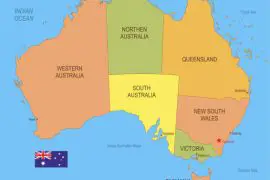Contents
Australia Coordenadas -Introduction

You’ve finally made it to Australia, mate! After months of planning and saving, you’ve landed Down Under, ready to explore the wild Outback. But before you set off into that vast expanse of red sand and spinifex, you must get your bearings. Australia is huge, the sixth largest country in the world by area. You could only wander the bush for days with a firm grasp of latitude and longitude.
Lucky for you, Australia’s coordinates are quite straightforward to understand. The country spans from 10 to 44 degrees south latitude and 113 to 153 degrees east longitude. The lower the latitude, the closer you are to the equator; the higher the latitude, the closer you are to the South Pole. Longitude increases as you head east and decreases as you go west. Knowing these basic coordinates will help you spot kangaroos and emus in Kakadu National Park rather than circling Canberra for the umpteenth time. So get ready to navigate Australia’s wild open spaces—your Outback adventure awaits!
Geography Now! Australia: https://m.youtube.com/watch?v=ynHIlx5RgtI&pp=ygUVQXVzdHJhbGlhIGNvb3JkZW5hZGFz
What Are Latitude and Longitude?
To get around Australia, you’ll need to understand latitude and longitude. Latitude lines run horizontally and measure how far north or south a location is from the equator. Longitude lines run vertically and measure how far east or west a location is from the Prime Meridian in Greenwich, England.
Australia’s latitude ranges from about 10°S to 43°S. Like Darwin in the Northern Territory, the northern parts of Australia sit at lower latitudes and experience a tropical climate. As you travel further south to cities like Sydney, Melbourne and Hobart, the latitude increases, and the climate becomes more temperate.
Australia’s longitude spans from 113°E to 153°E. Western Australia sits between 113°E and 129°E, while the east coast states span from 141°E to 153°E. Knowing the longitude helps determine what time zone a location is in. For every 15° of longitude, the time changes by one hour.
To pinpoint a location, use the latitude and longitude coordinates. For example, Australia’s capital city Canberra is located at 35°15′S 149°07′E. The first number, 35°15′S, indicates the latitude (35 degrees 15 minutes south of the equator). The second number, 149°07′E, indicates the longitude (149 degrees 7 minutes east of the Prime Meridian).
You can navigate Australia’s vast open spaces by understanding latitude and longitude. Whether you want to explore the Red Center, the tropical Top End or anywhere in between, just check the coordinates, and you’ll know exactly where you stand. Happy exploring!
Australia’s Latitude Lines
Australia’s latitude lines run east to west across the continent, measuring how far south or north a location is from the equator. Around 15 to 20 degrees south, the northern parts of Australia experience a tropical savanna climate with hot weather all year round.
As you venture into the central Outback around 25 to 30 degrees south, summers are scorching hot while winters are cool and dry. This semi-arid grassland climate sees little rain, so most of the Outback is sparsely populated.
Further south, around 35 to 40 degrees, you’ll find a hot-summer Mediterranean climate with cool, rainy winters and hot, dry summers. Cities like Perth and Adelaide are located in this zone.
At 45 degrees south and below, a temperate oceanic climate dominates with mild summers and cool, rainy winters. The southern coastlines and Tasmania have a marine west coast climate with year-round rainfall and temperatures rarely dropping below freezing.
So depending on whether you want to escape cold winters or scorching summers, Australia’s range of latitudes provides the perfect destination. The diversity of landscapes, temperatures and climates means there’s an ideal spot for every season.
From the tropical Top End to the chilly Tasmanian wilderness, Australia’s latitude lines offer a glimpse into the dramatic contrasts of this vast island continent. No matter your interests, a land of adventure awaits. All you need is a sense of discovery!
Finding Longitude in Australia
Finding your location in the Australian Outback can be tricky without the right coordinates. Unlike many places, Australia does not use latitude and longitude based on the Prime Meridian in Greenwich, England. Instead, Australia developed its coordinate system with the Australia Geodetic Datum.
You’ll need to use the Geocentric Datum of Australia 2020 (GDA2020) to pinpoint your location. This updated system provides coordinates referenced to the Earth’s center of mass. The latitude and longitude coordinates are written in degrees, minutes, and seconds (DMS) or decimal degrees (DD). For example, the iconic Uluru landmark is located at 25°20′42′′S, 131°02′15′′E in DMS or -25.345°S, 131.0375°E in DD.
To convert your GPS coordinates to the GDA2020 system, you must adjust the positional offsets from the previous Geocentric Datum of Australia 1994 (GDA94) datum. Most GPS units and mapping systems offer an option to display coordinates in GDA2020, but you can also find free online conversion tools. Be aware that the further inland you travel, the more the coordinates may differ between the two systems. Converting your location and recording both sets of coordinates is the safest option when navigating remote areas.
Understanding Australia’s longitude and latitude system is key to exploring the Outback, whether using a GPS device, topographic maps, or navigating by the sun and stars. Take the time to learn how to read coordinates in DMS and DD properly, and always double-check that your navigation aids are set to the updated GDA2020 datum. With the proper precautions, you’ll be well on your way to an epic Australian adventure. But if you get turned around, don’t panic – whip out those coordinates and get back on track! The Outback is meant for exploring, after all.
To navigate the vast Outback, you must get familiar with Australia’s coordinate system. The country uses geographic coordinates based on latitude and longitude to precisely locate any point.
Latitude lines run horizontally and measure how far north or south a place is from the equator. Longitude lines run vertically and measure how far east or west a place is from the Prime Meridian line in Greenwich, UK. Where the latitude and longitude lines intersect is a specific geographic coordinate.
Finding Your Coordinates
You can find the coordinates for any location in Australia on topographic or satellite maps. The coordinates will be written as two numbers, like -23.7136° S, 133.8807° E. The first number is the latitude, either north (+) or south (-) of the equator. The second is the longitude, either east (+) or west (-) of the Prime Meridian.
So those coordinates pinpoint a location 23.7136° south of the equator and 133.8807° east of the Prime Meridian. With coordinates in hand, you can enter them into a GPS device to navigate to that precise point.
Staying on Track
Once your destination’s coordinates are programmed into your GPS, follow the directions to stay on course in the Outback. The GPS uses satellite data to track and compare your location to the saved coordinates, providing turn-by-turn directions to guide you. Be careful to follow the GPS exactly; veering off course in such a remote area can be dangerous.
With some practice, you’ll read maps and enter coordinates like a pro in no time. And your new navigation skills will allow you to explore all the Outback has to offer. So pack your GPS, grab some coordinates, and prepare for an Australian bush adventure!
FAQ: Common Questions About Australia’s Coordenadas
Australia’s coordinates can be confusing if you’re unfamiliar with latitude and longitude. Here are some common questions to help get you oriented.
What do latitude and longitude measure?
Longitude measures how far east or west a location is from the Prime Meridian line that passes through Greenwich, England.
What are Australia’s latitude and longitude coordinates?
Australia’s coordinates span a wide range since it’s such a large country. The northernmost point is at 10°41’S latitude and 142°32’E longitude. The southernmost point is at 39°12’S latitude and 146°22’E longitude. The westernmost point is at 26°08’S latitude and 113°09’E longitude. The easternmost point is at 15°43’S latitude and 153°38’E longitude.
Why are there negative and positive coordinates?
The latitude coordinates south of the equator, and longitude coordinates west of the Prime Meridian are expressed as negative numbers. North and east are positive. So Australia’s northern latitudes are negative since Australia is in the Southern Hemisphere, while eastern longitudes are positive.
What is the geographic center of Australia
The geographic center of Australia is located at 23°39’S latitude and 133°12’E longitude. It’s in the Northern Territory, near the border with Western Australia and South Australia.
How can I use latitude and longitude to find a location in Australia?
You can precisely pinpoint any location in Australia with latitude and longitude coordinates. Enter the coordinates into digital maps, GPS devices, or other navigation tools, and it will show you the exact spot. Latitude and longitude provide an absolute reference system to find remote places that may not have a street address.
This helps clarify some confusion about Australia’s latitude and longitude coordinates. Let me know if you have any other questions!
Conclusion
So there you have everything you need to know to navigate Australia’s wild Outback successfully. With the right maps and equipment, a sense of adventure, and knowing how latitude and longitude guide you, you’ll be all set for an epic Aussie road trip. The coordinates will be your compass, leading you from coastal cities into the Red Center and beyond. Remember, the Outback is as harsh as it is breathtaking, so go prepared. But for those willing to venture into Australia’s heart, the rewards of navigating by latitude and longitude across open skies and rust-red Earth are life-changing. Head into the Outback, follow your coordinates, and see where the open road takes you!
More Links:
Unveiling the Hottest Job Prospects in Australia 2023: What is the most in demand job in Australia? in 2023: https://ausizealand.com/what-is-the-most-in-demand-job-in-australia-2023/





